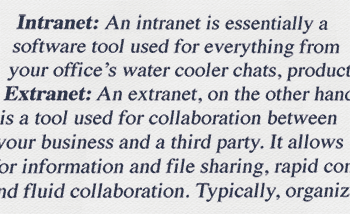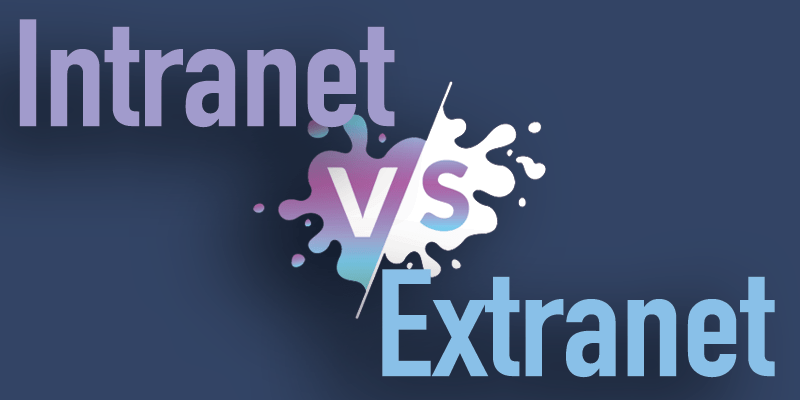Let’s face it; technology can be confusing. And it doesn’t help when the jargon all sounds the same —intranet, extranet… internet vs extranet. What’s the difference?
In this post, we clear up some of the confusion and set the record straight on intranet vs extranet. Using easy-to-understand language, we will set out what each platform does as we discuss the differences and similarities.
The bottom line is intranets and extranets will increase efficiencies, streamline workflows and improve communications. However, with an intranet, the emphasis is internal, whereas it’s external with an extranet.
What’s the best option for you? The aim here is to help you make an informed choice about the right solution for your business. Sharing real-examples, we demonstrate the contribution an intranet and extranet can make within the digital workplace.
Understanding The Basics Of Intranet vs Extranet
Let’s get started with the basics. What is an intranet, and what is an extranet? Here’s a quick definition:
Intranet

Extranet
An extranet, on the other hand, is a secure online, external communication and information network. It’s designed to support information and file sharing, rapid communication, and fluid collaboration with external partners. It could be clients, vendors, franchisees, or suppliers. Most often, businesses use extranets to gain efficiencies and add value to customer and supplier relationships.
So, when it comes to understanding the difference between intranet vs extranet, here’s the main takeaway message. An intranet is just for your internal people to use, whereas an extranet is for internal and external people to use together.
Advantages Of Using An Intranet
An intranet platform delivers many business benefits. Here are just a few highlights.
Improved Internal Communications
From corporate messages and transactional comms to casual conversations, the intranet improves and enhances internal communications. The intranet’s wide selection of integrated tools supports anytime, anywhere internal communications. Take your pick from instant messaging, blogs, newsfeeds, and videos to connect managers and staff no matter their location.
Streamlined Workflows And Approvals
Do away with slow and inefficient email and paper trails. Online workflows and approval processes speed up decision-making. And they reduce the possibility of information going missing or human error creeping in. The intranet’s online forms will increase productivity while saving you time and money.
Centralized Corporate Information
The intranet is the central, go-to hub for all company data. Using a self-service approach, employees can easily find information. Whether it’s a product specification, marketing strategy, or SOPs, the intranet is the organization’s single source of truth.
Easier Collaboration and Joint Working
With remote working now the new normal after Covid-19, the intranet provides endless opportunities to collaborate. Online forums and project spaces allow teams to brainstorm, share insights, problem solve, and work collaboratively. Embed Google Workspace or Office 365 apps for real-time editing and secure document storage.
Advantages Of Using An Extranet
In addition to all the great benefits discussed above, extranets have unique advantages. Extranets offer a simple solution for data exchange, collaboration, and knowledge sharing with external partners. Here are just a few of the many benefits.
Enhanced Data and Information Sharing
Extranet software enables you to exchange large volumes of data with external partners in one secure platform. What’s more, interactions take place in real-time. Whether it’s inventory management, customer orders, or knowledge sharing, extranets streamline processes and provide a better customer experience.
Guaranteed Safety and Security
The latest online security features safeguard all extranet communications. Data exchanges are encrypted over a VPN, protecting confidential and sensitive data. And integrated controls restrict access to those personnel that need it. These features are critical in the context of many industries, such as healthcare, insurance, and banking.
Improved Collaboration and Knowledge Sharing
Just as your employees have more opportunities to collaborate and share knowledge, so too can your partners. Project management with external partners becomes a whole lot easier. Clients and employees can share documents, ask questions, and problem-solve in one central virtual space.
Increased Customer Satisfaction
Extranets are working for you 24/7. Clients and customers have open-all-hours access to data, tools, and information. Extranets help break down the barriers caused by different time zones, work schedules, and locations. The result is an enhanced customer experience and increased satisfaction.
Intranets vs Extranets: Finding Common Ground
Though intranets and extranets have been developed to perform different functions, there are several similarities. The simple fact is that extranets are, in essence, an expanded form of the intranet.
As we have seen, both exist to drive collaboration. An intranet makes it easy to communicate with your internal staff. And it also supports cross-team communications. One uniform platform is a more effective channel for senior leaders to broadcast corporate messages. Furthermore, team pages enable collaboration on specific projects in real-time, supported by team chat and file sharing.
Extranets function in a similar way to facilitate collaboration with partners. Instead of messy email chains and phone calls bouncing back and forth, organizations collaborate with customers and suppliers more effectively. All communication takes place in one easy-to-use platform. Information and file sharing becomes a whole lot easier, increasing access to knowledge for both parties.

Similarly, extranets enable third-party information and communications to occur on the fly. Rather than relying on email, both parties have instant access to information through the extranet. Ultimately, intranets and extranets enable flexibility, convenience, and efficiency through remote access.
Finally, both platforms include impressive functionality that streamlines many standard business processes. Intranets provide information sharing, newsfeeds, private forums, company calendars, data storage, and much more. Extranets build on this functionality, offering higher levels of data sharing. Both are capable of performing a variety of tasks, whether internally or externally focused.
Intranet vs Extranet: Aren’t They The Same Thing?
Because intranet and extranet both sound the same, many mistakenly believe they do the same thing. As we have seen, both function in overlapping areas. However, they also have distinct differences, mainly focusing on intent.

Although still a fantastic tool for engaging with external partners, extranets have a different emphasis. Their intent is more about clear, efficient communication and the secure exchange of data and knowledge.
The value proposition of the two technologies is, therefore, slightly different. Extranet software adds value to customers and suppliers. The increased transparency of data, reduced errors, and enhanced response times contribute to more efficient relationships with external partners. By comparison, intranets are much more internally focused. They add value to the organization itself by improving communications, collaboration, and engagement.
Intranet vs Extranet – Which Option Works Best?
Equipped with a better understanding of the functions of intranets vs extranets, it’s time to choose the best platform for you. To help you make that choice, here are some real-life examples of how organizations are using the software.
Intranet Use Cases
Idaho Lottery
For MyHub customer Idaho Lottery, internal communications was the driving force behind the intranet. Employees work throughout the state and are often out on the road. Email was no longer cutting it. Plus, the organization had concerns about the security of its sensitive information and data.
The introduction of an intranet has simplified internal communications. All staff are kept informed and updated through one central platform. What’s more, employees can securely share information with head office from any location.
Idaho Lottery has even set up an extranet arrangement. The extranet has made it easier to share marketing and promotional materials with external vendors.
Find out more about how Idaho Lottery is using an intranet here.
Kenect Recruitment
MyHub customer Kenect Recruitment is using its intranet to support streamlined business processes and workflows. The company operates a franchise business model and has several office locations.
Kenect Recruitment uses intranet-embedded Google Workspace apps for more efficient operations. One example is the introduction of league tables based on branch performance. Before the MyHub intranet, the company used email to circulate league tables. However, the data quickly became out of date, which impacted its effectiveness as a motivation tool. The introduction of intranet-embedded Google Sheets has transformed the friendly inter-office competition. All data is now in real-time and is readily accessible to staff.
Check out the Kenect Recruitment case study for more information.
Extranet Use Cases
Businesses use extranets in a variety of ways. Colleges and universities utilize extranet software for the payment of fees and to share information with students and parents. Manufacturers use the extranet to promote collaboration and communication with suppliers. The result is streamlined supply chains and budgetary savings. And designers, law firms, and accountants exchange information with clients and customers via the extranet for more responsive customer service.
Here are some examples of extranets in action from MyHub’s customers.
Sass
Business consultancy firm Sass provides accountancy, book-keeping, marketing, and HR to various companies, including SMEs. Sass set up an extranet to provide clients with round-the-clock access to expert knowledge, documentation, and training resources.
Each client has a secure login and private folders to store confidential business information. Plus, they can access a subscription-based library packed with useful resources. The extranet means clients can draw on specialist training videos, business templates, FAQs, and help when they need it. Sass clients feel supported 24/7. The extranet has added value to Sass customers. And it has reduced the business’s central overheads as Sass staff are no longer on call all the time.
Find out more about the difference the extranet has made to Sass customers here.
P4B Law
Specialist employment law practice, P4B Law, uses an extranet to keep clients updated with case law changes and judgments. The extranet allows P4B to provide tailored services to individual clients, depending on their needs and interests. And it means the practice can quickly get information out to clients.
The responsive, flexible service has increased customer satisfaction. Plus, clients have complete confidence they are accessing up-to-the-minute information. And in the field of employment law, this feature is critical.
More information on P4B Law’s extranet is available here.
Intranet vs Extranet: Expert Help And Advice
When considering which option is best for your business, ask yourself: What are we trying to achieve here? Do we want to improve our customer interactions? An extranet will help you communicate better, streamline processes, and share large amounts of data with third parties. Or perhaps your focus is more internal. Maybe you want to improve internal communications, collaboration, and employee engagement.
If the driving force is more efficient and effective relationships with external partners, then an extranet is probably the best choice. However, if employees struggle with remote working and internal communications is an issue, an intranet will work wonders.
Many companies find that an intranet is a great launching pad for a fully functional extranet. Because of the similarities and the internal benefits on offer, starting with an intranet means employees get used to using the platform. Moving on to an extranet is then a much smoother transition.
The team at MyHub is here to help. Our experience covers intranets and extranets of all shapes and sizes. We have the knowledge and expertise to help you make the right decision.
Sign up for a free 14-day trial of MyHub’s software or book your free demo here.









